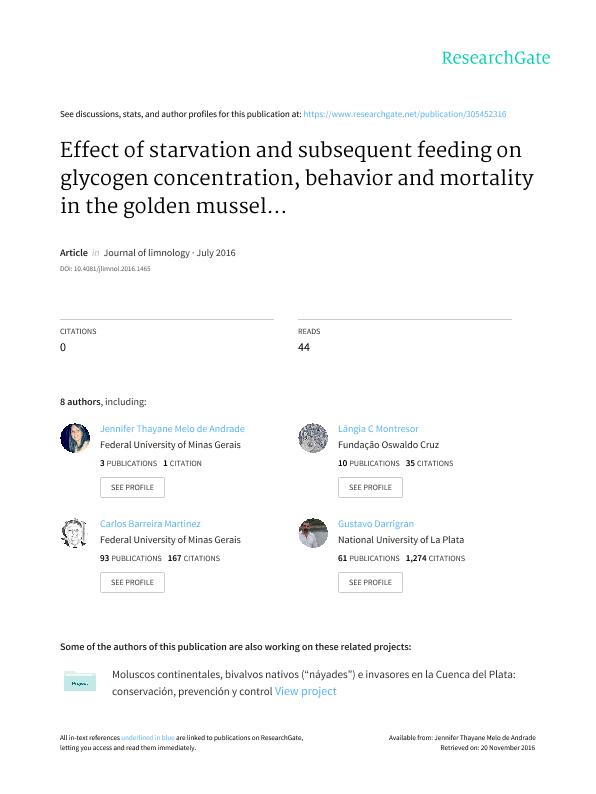Mostrar el registro sencillo del ítem
dc.contributor.author
Cordeiro, Nelmara I. S.
dc.contributor.author
Andrade, Jennifer T. M.
dc.contributor.author
Montresor, Lângia C.
dc.contributor.author
Luz, Dalva M. R.
dc.contributor.author
Martinez, Carlos B.
dc.contributor.author
Darrigran, Gustavo Alberto

dc.contributor.author
Pinheiro, Jairo
dc.contributor.author
Vidigal, Teofânia H. D. A.
dc.date.available
2018-08-13T17:45:56Z
dc.date.issued
2016-07
dc.identifier.citation
Cordeiro, Nelmara I. S.; Andrade, Jennifer T. M.; Montresor, Lângia C.; Luz, Dalva M. R.; Martinez, Carlos B.; et al.; Effect of starvation and subsequent feeding on glycogen concentration, behavior and mortality in the golden mussel Limnoperna Fortunei (Dunker, 1857) (Bivalvia: Mytilidae); Cnr Ist Italiano Idrobiologia; Journal of Limnology; 75; 3; 7-2016; 618-625
dc.identifier.issn
1723-8633
dc.identifier.uri
http://hdl.handle.net/11336/55152
dc.description.abstract
The success of Limnoperna fortunei as an invasive species is related to its physiological plasticity that allows them to endure adverse environmental conditions. Starvation tolerance is considered to be an important trait associated with bivalve invasiveness. In natural ecosystems, food resources can vary during the year, exposing mussels to variable periods of starvation or limited food availability. Thus, mussels have developed physiological strategies to tolerate fluctuations in food availability. Glycogen concentration has been used in different monitoring studies as an indicator of the nutritional condition of bivalves. The aim of this study was to investigate the physiological responses of L. fortunei based on the glycogen concentrations of specimens under four treatments, comprising differentcombinations of feeding and starvation, during 125 days. The experiment was carried out in two phases. In the phase I, mussels were divided in two treatments: starvation (S) and feeding (F). After 100 days, tissue samples were collected to quantify glycogen concentrations and, each phase I group was divided in two subgroups: starvation (S) and feeding (F), resulting in four treatments. In the phase II, that lasted 25 days, starvation specimens (S) from phase I were allowed to feed (starvation-feeding treatment, or S-F), or continued to undergo starvation (starvation-starvation treatment, or S-S) and the feeding specimens (F) continued feeding (feeding-feeding group, or F-F), or were subjected to starvation (feeding-starvation treatment, or F-S). Behavior (valve-closing) and mortality were recorded in 24 h intervals. After the 25 days (phase II) all specimens were killed, and thei r soft tissue was removed to quantify glycogen concentrations. The glycogen concentration of the S-F treatment was lower than that of the F-S treatment, which was initially allowed to feed (phase I) and then subjected to starvation (phase II). Stability in the glycogen concentrations was observed when the phase II feeding conditions were maintained during the experiments, as observed in the S-S (continued starvation) and F-F (continued feeding) treatments. Based on our glycogen concentrations results, the golden mussel shows a higher tolerance to starvation (125 days) than has previously been published, which suggests that its tolerance strongly influences its invasive behavior.
dc.format
application/pdf
dc.language.iso
eng
dc.publisher
Cnr Ist Italiano Idrobiologia

dc.rights
info:eu-repo/semantics/openAccess
dc.rights.uri
https://creativecommons.org/licenses/by-nc-sa/2.5/ar/
dc.subject
Bioinvasion
dc.subject
Comparative Physiology
dc.subject
Glycogen
dc.subject
Golden Mussel
dc.subject
Starvation
dc.subject.classification
Otras Ciencias Biológicas

dc.subject.classification
Ciencias Biológicas

dc.subject.classification
CIENCIAS NATURALES Y EXACTAS

dc.title
Effect of starvation and subsequent feeding on glycogen concentration, behavior and mortality in the golden mussel Limnoperna Fortunei (Dunker, 1857) (Bivalvia: Mytilidae)
dc.type
info:eu-repo/semantics/article
dc.type
info:ar-repo/semantics/artículo
dc.type
info:eu-repo/semantics/publishedVersion
dc.date.updated
2018-08-08T14:58:46Z
dc.identifier.eissn
1129-5767
dc.journal.volume
75
dc.journal.number
3
dc.journal.pagination
618-625
dc.journal.pais
Italia

dc.journal.ciudad
Pallanza
dc.description.fil
Fil: Cordeiro, Nelmara I. S.. Universidade Federal de Minas Gerais; Brasil
dc.description.fil
Fil: Andrade, Jennifer T. M.. Universidade Federal de Minas Gerais; Brasil
dc.description.fil
Fil: Montresor, Lângia C.. Fundación Oswaldo Cruz; Brasil
dc.description.fil
Fil: Luz, Dalva M. R.. Universidade Federal de Minas Gerais; Brasil
dc.description.fil
Fil: Martinez, Carlos B.. Universidade Federal de Minas Gerais; Brasil
dc.description.fil
Fil: Darrigran, Gustavo Alberto. Consejo Nacional de Investigaciones Científicas y Técnicas; Argentina. Universidad Nacional de la Plata. Facultad de Ciencias Naturales y Museo. División Zoología Invertebrados; Argentina
dc.description.fil
Fil: Pinheiro, Jairo. Universidade Federal Rural Do Rio de Janeiro;
dc.description.fil
Fil: Vidigal, Teofânia H. D. A.. Universidade Federal de Minas Gerais; Brasil
dc.journal.title
Journal of Limnology

dc.relation.alternativeid
info:eu-repo/semantics/altIdentifier/doi/https://dx.doi.org/10.4081/jlimnol.2016.1465
dc.relation.alternativeid
info:eu-repo/semantics/altIdentifier/url/https://www.jlimnol.it/index.php/jlimnol/article/view/jlimnol.2016.1465
Archivos asociados
